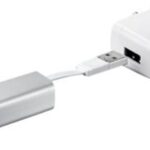Charging a power bank with another power bank might seem odd. But it’s possible and sometimes necessary.
Imagine you’re on a trip, and all your devices need charging. Your main power bank is running low, and there’s no outlet nearby. This is where charging a power bank with another power bank comes in handy. It can extend the life of your devices and keep you connected.
This process can be useful in emergencies or when traveling. By understanding how to do this correctly, you can ensure your devices stay powered up. Let’s explore this topic and see how it works.

Credit: www.youtube.com
Types Of Power Banks
When it comes to charging your devices on the go, power banks are essential. But not all power banks are the same. They come in different types, each with unique features. Understanding these types will help you choose the right one for your needs.
Standard Power Banks
Standard power banks are the most common type. They are portable, easy to carry, and ideal for everyday use. These power banks typically have a capacity range of 5,000mAh to 10,000mAh. They can charge a smartphone one to two times. Standard power banks are perfect for short trips or daily commuting.
| Feature | Description |
|---|---|
| Capacity | 5,000mAh to 10,000mAh |
| Weight | Lightweight, easy to carry |
| Usage | Charges a smartphone 1-2 times |
High-capacity Power Banks
High-capacity power banks are designed for heavy usage. They have a capacity above 10,000mAh, often reaching 20,000mAh or more. These power banks can charge a smartphone multiple times or even power larger devices like tablets and laptops. High-capacity power banks are bulkier, but they are perfect for longer trips or heavy device usage.
- Capacity: Above 10,000mAh
- Weight: Heavier, less portable
- Usage: Charges multiple devices, suitable for long trips

Credit: www.amazon.com
Choosing Compatible Power Banks
Choosing compatible power banks is essential for efficient charging. Not all power banks can charge each other effectively. Ensuring compatibility helps you avoid damage and ensures optimal performance. Let’s explore the key factors to consider: capacity matching and port compatibility.
Capacity Matching
Capacity matching is crucial when charging power banks with other power banks. Ensure the capacity of both power banks is similar. This prevents overcharging or undercharging issues. Here’s a simple guide:
- Similar Capacity: Choose power banks with similar mAh ratings.
- Balanced Charging: Avoid large capacity differences.
- Safety: Prevents potential damage to either power bank.
For example, a 10,000mAh power bank pairs well with another 10,000mAh unit. This ensures efficient energy transfer and safe charging.
Port Compatibility
Port compatibility is another vital aspect. Ensure both power banks have matching ports. This ensures proper connection and efficient energy transfer. Consider the following:
| Port Type | Description |
|---|---|
| USB-A | Standard USB port found in many devices. |
| USB-C | Newer, reversible USB port for faster charging. |
| Micro-USB | Older, smaller USB port for older devices. |
Use matching ports for optimal charging. A USB-C to USB-C connection is ideal for modern devices. Avoid using adapters as they can reduce efficiency.
Step-by-step Charging Process
Charging one power bank with another is a simple task. Follow these steps to ensure a smooth charging process. This guide will help you understand how to prepare and connect your power banks effectively.
Preparing The Power Banks
Before you start, ensure both power banks are in good condition. Check the battery levels of both power banks. The power bank you want to charge should be low on battery, and the other should have a sufficient charge.
Next, gather the necessary cables. You typically need a USB cable. Ensure the cable is compatible with both power banks. A damaged or incompatible cable can hinder the charging process.
It’s also important to find a stable surface. This prevents any accidental disconnections during charging. A clean, flat table or desk is ideal for this purpose.
Connecting The Power Banks
Once everything is prepared, you can start connecting the power banks. Follow these steps:
- Connect the USB cable to the output port of the charged power bank.
- Plug the other end of the cable into the input port of the low battery power bank.
- Ensure the connections are secure. Loose connections can interrupt the charging process.
- Turn on the power bank that will supply the charge. Most power banks have a power button.
After connecting, check the indicator lights. These lights show the charging status. If the lights are on, the charging process has begun. Monitor the power banks periodically to ensure everything is working correctly.
Using one power bank to charge another can be handy in emergencies. Follow these steps carefully to ensure an efficient charging process.
Efficiency And Performance
Charging a power bank with another power bank is a convenient option. But understanding the efficiency and performance is crucial. This section explores how effective this method is.
Charging Speeds
The charging speeds of power banks vary. It depends on the power output and input ratings. Most power banks have a standard USB output of 5V/2A. Some advanced models offer higher speeds with USB-C or fast-charging technology.
Here is a table showing typical charging speeds:
| Type | Output | Input |
|---|---|---|
| Standard USB | 5V/2A | 5V/2A |
| Fast Charging | 9V/2A | 9V/2A |
| USB-C | 5V/3A | 5V/3A |
Power Loss Factors
Power loss factors are significant in the charging process. It occurs due to resistance in cables and internal circuits. This results in energy not fully transferring from one power bank to another.
Several factors contribute to power loss:
- Cable Quality: High-resistance cables cause more power loss.
- Conversion Efficiency: Some energy is lost during voltage conversion.
- Battery Health: Older batteries may not hold charge efficiently.
Reducing these factors can improve charging efficiency. Choosing high-quality cables and maintaining battery health is essential.
Potential Risks And Mitigation
Charging a power bank with another power bank might seem convenient. But it poses certain risks. Understanding these risks can help you take preventive measures. This section discusses common issues like overheating and battery degradation. It also provides practical tips to mitigate these risks.
Overheating Issues
Overheating is a common problem when charging a power bank with another power bank. Heat can damage batteries and reduce their lifespan. Both power banks generate heat during charging. This combined heat can become excessive.
Here are some tips to mitigate overheating:
- Avoid charging in hot environments. Keep the power banks in a cool place.
- Place the power banks on a hard, flat surface. This helps dissipate heat.
- Ensure proper ventilation. Do not cover the power banks while charging.
- Use a power bank with a built-in cooling system. This helps manage heat better.
Battery Degradation
Frequent charging with another power bank can degrade the battery. Batteries have a limited number of charge cycles. Using them to charge each other increases the number of cycles.
Here are some ways to reduce battery degradation:
- Avoid using power banks for mutual charging regularly. Use wall chargers whenever possible.
- Choose power banks with high capacity. This reduces the need for frequent charging.
- Use quality power banks. Cheap ones often have poor battery management systems.
- Do not fully drain or fully charge the batteries. Keep the charge between 20% and 80%.
Taking these steps can help prolong the life of your power banks. Always prioritize safety and battery health.
Alternative Charging Methods
Charging a power bank with another power bank can be convenient. Still, there are other ways to charge your power bank. These methods can be more effective and might suit your needs better. Let’s explore some of these alternative charging methods.
Solar Charging
Solar charging uses the power of the sun to charge your power bank. This method is especially useful for outdoor activities or emergencies. To use solar charging, you need a solar panel compatible with your power bank.
Here’s a simple way to set up solar charging:
- Place the solar panel in direct sunlight.
- Connect the solar panel to your power bank using the appropriate cable.
- Ensure the solar panel is stable and facing the sun directly.
It might take a longer time compared to other methods. But it’s a reliable and eco-friendly option.
Wall Charging
Wall charging is the most common and efficient method. It involves plugging your power bank into a wall socket using a charger. Most power banks come with a USB cable and wall adapter for this purpose.
Follow these steps for wall charging:
- Connect your power bank to the charger using the USB cable.
- Plug the charger into a wall socket.
- Ensure the power bank is charging by checking the LED indicator.
This method is quick and reliable. It ensures your power bank is fully charged in a short time.

Credit: naztech.com
Frequently Asked Questions
Can You Charge A Power Bank With Another Power Bank?
Yes, you can charge a power bank using another power bank. However, this is inefficient. Energy loss occurs during the transfer.
Is It Safe To Charge A Power Bank With Another?
Charging a power bank with another is generally safe. Ensure both are of good quality. Avoid overcharging.
How To Charge A Power Bank With Another Power Bank?
Connect the output of one power bank to the input of the other. Use the appropriate USB cable.
Does Charging One Power Bank With Another Damage Them?
No, it doesn’t generally damage them. However, frequent use can reduce their lifespan due to energy loss.
Conclusion
Charging a power bank with another power bank is possible, but not ideal. It’s better to charge each directly from a wall outlet. This ensures faster and more efficient charging. Always use quality cables and chargers to avoid damage. Keep your devices in good condition for longer life.
Understand your power bank’s specifications to avoid mishaps. Safety first. Proper charging practices save time and money. Happy charging!







